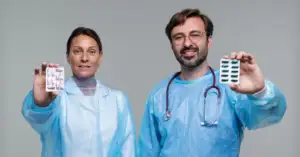Novel drug delivery systems represent a revolutionary approach in the field of pharmaceuticals, aiming to enhance therapeutic efficacy, improve patient compliance, and mitigate adverse effects. These systems encompass a diverse range of technologies designed to optimize drug administration, targeting, and release kinetics. From sophisticated nanoparticle formulations to advanced implants and transdermal patches, novel drug delivery strategies offer unprecedented opportunities to tailor treatment regimens to individual patient needs. By harnessing innovative materials and engineering principles, these systems hold the promise of revolutionizing drug therapy across various medical disciplines, heralding a new era of precision medicine and improved patient outcomes.
Global clinical trials often incorporate novel drug delivery systems to evaluate their efficacy and safety across diverse patient populations worldwide. Global clinical trials involving novel drug delivery must navigate complex regulatory landscapes, ensuring compliance with international standards and local regulations. Successful global clinical trials of novel drug delivery systems pave the way for market expansion by demonstrating the feasibility and benefits of these advancements on a broader scale.
Pharmaceutical manufacturers often collaborate with researchers specializing in novel drug delivery systems to develop enhanced formulations of existing drugs. Pharmaceutical manufacturers frequently seek to license or acquire patents related to novel drug delivery technologies. By securing exclusive rights to these innovations, pharmaceutical manufacturers can develop proprietary products with improved therapeutic profiles and gain a competitive edge in the market.
Here are some common types:
- Nanoparticles: These are submicron-sized colloidal particles that can encapsulate drugs, improving their solubility, stability, and targeting. Nanoparticles can be made from various materials such as lipids, polymers, or metals.
- Liposomes: Liposomes are spherical vesicles composed of lipid bilayers. They can encapsulate both hydrophilic and hydrophobic drugs, protecting them from degradation and improving their bioavailability.
- Micelles: Micelles are self-assembled colloidal nanoparticles formed by amphiphilic molecules in aqueous solutions. They can solubilize hydrophobic drugs and enhance their delivery.
- Polymeric Drug Delivery Systems: These systems utilize biodegradable polymers to encapsulate drugs and control their release kinetics. They can be tailored to release drugs over extended periods, providing sustained therapeutic effects.
- Dendrimers: Dendrimers are highly branched, tree-like synthetic polymers with well-defined structures. They can be functionalized to carry drugs and target specific tissues or cells.
- Implants: Implantable drug delivery systems involve the insertion of drug-containing devices into the body, where they release drugs gradually over time. Examples include drug-eluting stents and contraceptive implants.
- Transdermal Patches: Transdermal patches deliver drugs through the skin and into the systemic circulation. They offer controlled release and are convenient for long-term therapy.
- Inhalation Systems: Inhalable drug delivery systems deliver drugs directly to the lungs, making them effective for treating respiratory conditions. They include metered-dose inhalers, dry powder inhalers, and nebulizers.
- Targeted Drug Delivery Systems: These systems are designed to deliver drugs specifically to the site of action, minimizing systemic side effects. Targeting can be achieved through ligand-receptor interactions, magnetic targeting, or pH-responsive mechanisms.
- Gene Delivery Systems: Gene delivery systems are used to introduce therapeutic genes into target cells for the treatment of genetic disorders or to modulate cellular functions. They include viral vectors, non-viral vectors, and gene editing technologies like CRISPR-Cas9.
Novel drug delivery systems offer several advantages over conventional methods, revolutionizing the field of pharmacotherapy. Here are some key advantages:
- Enhanced Drug Efficacy: Novel drug delivery systems allow for precise control over drug release rates, concentrations, and targeting, leading to improved therapeutic outcomes. This ensures that the drug reaches its intended site of action in the body at the right dose and for the desired duration.
- Improved Patient Compliance: Many novel drug delivery systems offer simplified dosing schedules, such as sustained-release formulations or long-acting injectables, reducing the frequency of administration. This convenience enhances patient adherence to treatment regimens, resulting in better clinical outcomes.
- Minimized Side Effects: Controlled drug release and targeted delivery mechanisms can reduce systemic exposure to drugs, minimizing adverse effects on healthy tissues and organs. This selective drug delivery helps to maintain therapeutic concentrations at the site of action while minimizing toxicity elsewhere in the body.
- Optimized Pharmacokinetics: Novel drug delivery systems can modulate the pharmacokinetic profile of drugs, allowing for tailored release kinetics based on the drug’s properties and therapeutic requirements. This can result in prolonged drug action, reduced dosing frequency, and improved bioavailability.
- Targeted Drug Delivery: Advanced delivery systems enable precise targeting of drugs to specific tissues, cells, or cellular compartments, enhancing therapeutic efficacy while minimizing off-target effects. Targeted delivery can be achieved through various strategies, including ligand-receptor interactions, nanoparticle formulations, and stimuli-responsive drug carriers.
- Improved Stability: Some novel delivery systems protect drugs from degradation, increasing their stability and shelf life. This is particularly beneficial for drugs that are susceptible to degradation in physiological conditions or during storage.
- Combination Therapies: Novel drug delivery systems facilitate the co-delivery of multiple therapeutic agents, enabling synergistic effects and enhanced therapeutic outcomes. This approach is particularly useful for complex diseases that require multimodal treatment strategies.
- Customization and Personalization: Advances in drug delivery technology allow for customization of treatments based on individual patient characteristics, such as genetic makeup, disease state, and drug response. Personalized drug delivery strategies have the potential to optimize therapeutic outcomes and minimize adverse effects on a patient-specific basis.
In conclusion, novel drug delivery systems offer promising avenues for enhancing drug efficacy, improving patient compliance, and minimizing adverse effects. Through innovative technologies and formulations, these systems continue to revolutionize the landscape of pharmaceuticals, paving the way for more targeted and personalized therapies in the future.





